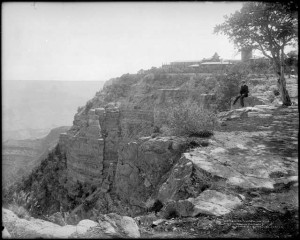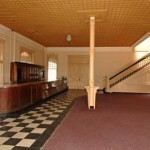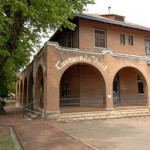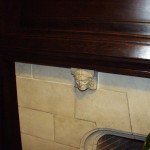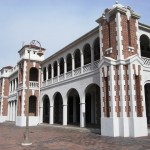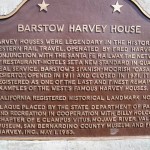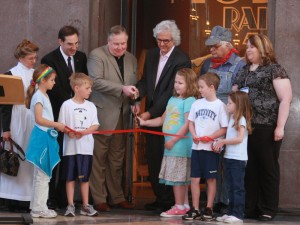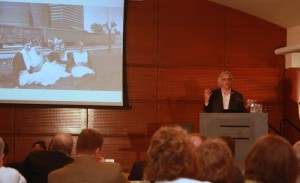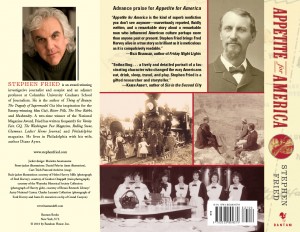26
Interesting piece in the Grand Canyon News about the book and Fred’s impact on the canyon.
21
The classic mission style Harvey House building in Las Vegas, NM–the old Castaneda hotel, the site of everything from the Rough Riders reunion of 1899 and the filming of No Country for Old Men–is still for sale, and is seriously in need of saving. Check out the real estate listing!
18
Several people were curious to see Ford Harvey’s famed second-floor office at KC Union Station, which has been nicely restored (or, more accurately, nicely never ruined in the first place) and is used as a conference room. Here’s a shot of me in front of the Mary Colter fireplace (which used to have four of those Indian heads, now two have mysteriously disappeared–anyone know where they are?). The black mimbreno pieces displayed on the mantle are not Ford’s and, for the most part, are the very good copies now available, not the originals. (FYI, mimbreno fans might be interested to know that El Tovar at the Grand Canyon now uses the black mimbreno exclusively in its dining room, to spectacular effect.)
14
Item posted on the site of KC alt-weekly The Pitch, by always-well-informed Charles Ferruzza, sounds like that space might no longer be an eatery. A shame–it has been really well-preserved for all these years (as has Ford Harvey’s old office on the second floor)
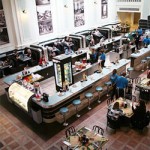
11
So, you want your personal copy of Appetite for America signed, or you want to give a signed book as a gift? Or you own a store and want to offer signed books? We now have available these very cool “May Fred be with you” bookplates, which I can sign and send to you. Just email me and let me know what you need.
11
Our Fred-friend Brenda Thowe, vehicle fleet manager at BNSF and part-time Harvey Girl-ologist, just had a chance to tour old Harvey House sites in California for work. Check out the pics she took of their various states of refurbishment or disrepair and posted on Facebook! Here are a couple to get you started from Barstow.
10
After my Parade cover story on America’s Greatest Train Rides came out, both Parade.com and I received a lot of emails from readers upset that they wanted to take the ride from Chicago to LA that we made sound like so much fun–but were unable to book it for fares anywhere near like the ones we had printed. We published, and Amtrak confirmed before publication, $909 for a couple traveling in a private bedroom with “shoilet” (as Diane calls the shower/commode combo), and $944 for a family of four traveling in a “family bedroom” that sleeps four (but is shoilet-free.) When the article came out on March 28, many people tried to book the trip and were e-quoted prices often double that. They were not e-lated.
When asked, Amtrak released a statement saying “fares will vary by time of year, date of purchase and choice of sleeping accommodations. The article … used an off-peak travel season as a starting point.” The truth is, we didn’t consciously use the off-season–we just happened to write and edit the article during the off-season, so those were the fares coming up on Amtrak’s web reservation service.
But the real answer to the fare question is much more complex. Since the Parade article came out just as we were about to take another ride on the Chief ourselves–for the One Nation Under Fred tour–I wasn’t able to immediately look into this further. But now I have. I just had a long talk with Marc Magliari, Amtrak’s Midwest Media Relations Manager (a good guy with a big voice with has helped us in the past).
And I can now explain the entire complicated situation to you–and help you book your trip the smartest and cheapest way possible.
First, I must confess I am something of an Amtrak.com geek. Because I ride the train from Philly to New York to teach at Columbia, and book online each week, I am very sensitive to every little change in fares on the Amtrak site. They don’t always announce these ticket-tweaks, but you can figure them out–recently, for example, out of nowhere, the lowest price between NY and Philly dropped from $47 to $35–ostensibly because of increased competition from buses. Finding that fare isn’t easy (and you can’t use your AAA discount on it) but it is worth pursuing.
But, back to the Chief. It turns out that at any given time there are four different possible fares for a seat on the Chief between Chicago and LA, and five different fares for the bedroom-plus-shoilet accommodations–anywhere from $617 to $1393 (and, if you pay for the bedroom, you automatically get the cheapest seat fares–which is why they both go quickly.) These shift based on the time of year and the demand. At any time of year, your best chance of getting the cheapest far is to book a departure leaving on a Tuesday or Wednesday. But the times Amtrak considers the most “off-season”–and sets fares accordingly–are mid-September through mid-October and mid-January through early March. There are times near then when you can still get the lowest rates, but the closer you get to any holiday or the summer, the worst your chances. And, for many dates, the bedrooms sell out–and, trust me, you want your own shoilet. (Don’t forget your shoiletries.)
Anyway, I hope this explains the wide variability in Southwest Chief fares. And if you were worried that the fare we printed would never be available again, don’t fret–I just went up on the site, chose the most obscure date possible, and got those fares we printed. So they do exist. Whoo-whoo!
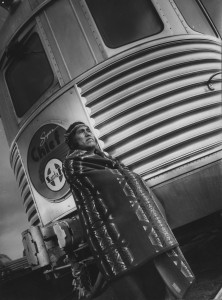
9
Check out this podcast of “The Restaurant Guys” whose radio show is sort of a culinary “Car Talk.” They are the first interviewers who really wanted to talk about Fred as a restaurateur, and how relevant his ideas still are today. Bon Appetit!
5
Those of you who have seen the C-Span Book TV broadcast of my talk at Kansas City Union Station might be interested in these nice shots we just got from that day. In the first, my co-ribbon-cutter is legendary railroad exec Mike Haverty, the last president of the Atchison, Topeka and Santa Fe before the BNSF merger, and now CEO of the Kansas City Southern and board president of Union Station. (This was the grand opening of their Model Railroad Experience display, which was pretty cool.) To his left are George Guastello, the CEO of Union Station and our new friend Bonnie Hansen, in one of her many authentic Harvey Girl outfits.
Bonnie’s husband, Peter, the editor of Railroad History (where he wrote a very kind review of the book), was the curator of the new exhibit there in the Kansas City Museum on Railroads and the National Parks–which, besides being really interesting, is the first show involving Fred Harvey to use the new dates established in the book for when he first came to the U.S. and many others. Actually, docents and historical lecturers all over the Midwest and Southwest now face the prospect of deciding whether or not to change the presentations they have been giving on Fred, the Harvey Girls and the Santa Fe–sometimes, literally, for decades–to reflect the new facts in the book. May Fred be with them. 😉
4
After my recent interview on the John Batchelor Show on WABC-AM in New York aired, I got an fascinating email from a listener on Long Island, custom furniture maker Rob Kron, who was intrigued by what he was finding out about Fred but also perplexed. His daughter, it turned out, is taking a college course on the American West and tourism, and one of the required texts, Devil’s Bargains: Tourism in the Twentieth-Century American West by Hal Rothman, in Rob’s words “demonizes Mr. Harvey, capitalism and America itself!” He said he was “very concerned that the education young people across the country are receiving is at times revisionist, and undermines and distorts their love, pride and appreciation of their country.”
Rob wanted to know, “Do you find that you are now criticized by left wing professors or others for offering your more positive perspective of this time period? I believe that we as people and as a nation can and should always strive to learn from the past so that we can improve our efforts when they have the potential of impacting others negatively. However, I believe that demonizing the American entrepreneurial spirit, and the innate desire to explore, tour and expand one’s boundaries to increase one’s knowledge of the greater world is actually an indictment of the human spirit…which is naive, ridiculous and ultimately very destructive.”
I wrote back: “I try, as much as possible, to explain during the narrative in my book the objections–from various people along the way–to what the Fred Harvey company did in the Southwest, which has a deeply embedded love/hate relationship with tourism and the railroads that brought tourism. In general, the people who criticized Harvey in the west were often businessmen who were upset that the Harvey company was more powerful than they, had the power of the trains behind it, and did business better–and, ultimately, put some of them out of business. I think their points of view are interesting and worthy of discussion, and perhaps professors who have been assigning those books will also begin assigning mine, because I had access to a lot more material than all previous books on Harvey and tourism. Once fully informed, they can make their own decisions.”
Rob ordered the book, checked out this blog, and then emailed me back with good news. His daughter has decided to write her final paper for the class–for which students get to select their own source material–on Appetite for America. Can’t wait to read it!
2
If you don’t have the book yet, or were considering it for a gift (Father’s Day is pretty soon), amazon is currently selling it for the absurdly low price of 14.85. Just follow this link!
1
From a review in the Lincoln Journal Star: “What a ride!…This is a marvelous look at a family and institution that was synonymous with the West for nearly a century, but which has now disappeared and is mostly forgotten. The Fred Harvey story is told here with all its majesty, dirty laundry, triumphs and failures in plain sight. It is well told and will capture readers as [well] as any fictional thriller. Except this is all reality.”
1
National Train Day is Saturday May 8–a perfect day for you and your family to visit your local train station for the festivities and then, of course, curl up with Appetite for America.
1
Listen to podcast of my talk at the Free Library of Philadelphia, which also includes a dialogue with author Bryant Simon, an expert on the sociology and politics of Starbucks.
